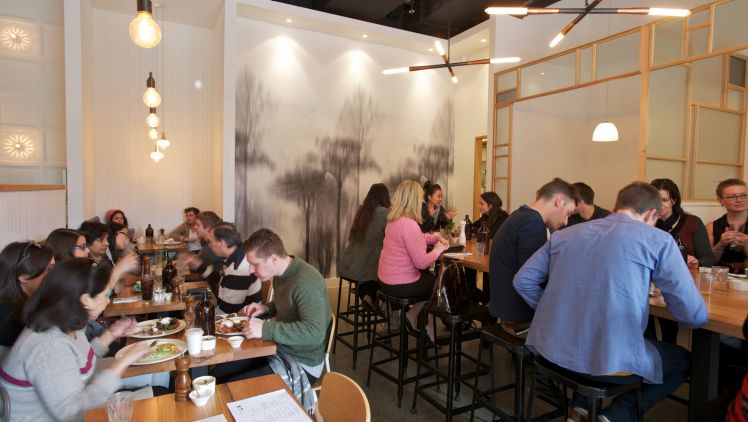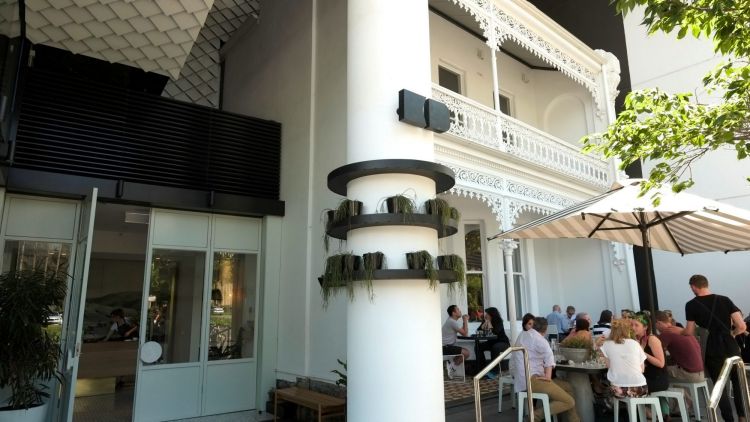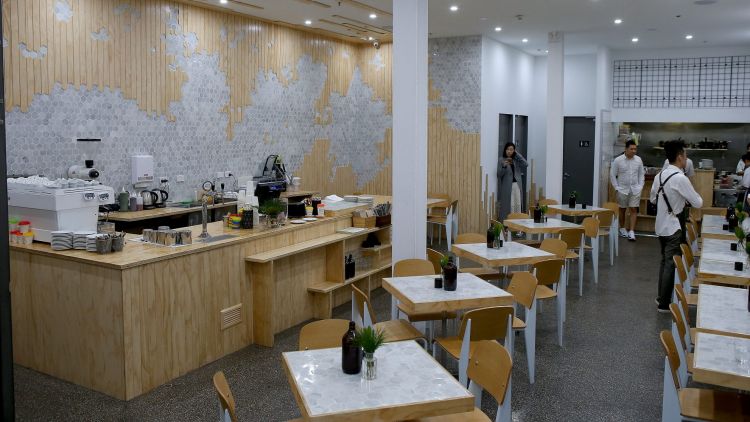This article was first published by Matt Holden on the 11th Sept 2016 via domain.com.au | Image: Senior project manager of the Far East Consortium Aaron Parfitt and owner of new cafe Higher Ground Nathan Toleman. Higher Ground is built in the old power station and forms the base of the building. Photo: Penny Stephens
On a Sunday morning, a queue forms outside the former powerhouse at the bottom of Little Bourke Street. “About 20 minutes,” says the waitperson adding names to a lengthening list. An espresso machine brews coffee to sip while patrons wait, a gas heater spreads a little island of warm air against the early spring chill.
The queue is for brunch at Higher Ground, one of Melbourne’s newest and smartest cafes. It’s the star retail attraction at Upper West Side, an apartment and retail development covering the old Age site and a stretch of Lonsdale Street that will eventually bring 10,000 new residents to the CBD, as well as a laneway-like setting for shops, cafes and restaurants.
Higher Ground’s co-owners Nathan Toleman, Ben Clark and Diamond Rozakeas are three of Melbourne’s smartest cafe operators, with form opening cafes in residential developments, including The Kettle Black in South Melbourne and Two Birds One Stone in South Yarra’s Lilli Apartments.
“A lot of the time developers tell you there are going to be so many hundred people living in the building,” says Nathan Toleman. “But you wouldn’t want to rely on the people living above you being your customers. Most of the time they’re at work during the day.”
“Ultimately we’re more interested in a unique site than in whether it’s part of an apartment development,” says Toleman. “This was a unique site. And we knew there was going to be a lot more development in the area.”
High-profile cafes are increasingly an important attraction in developments, says Upper West Side project manager Aaron Parfitt.
“Nathan is about creating a destination, not following on other people’s coattails,” Parfitt says. “We’re glad we have the flagship cafe that creates the tone we are trying to curate. We’re not just building another Westfield.”
The trend isn’t confined to the inner city. In Whitehorse Road, Balwyn, the upmarket Andalusian apartment building houses White Mojo, a high-ceilinged space trimmed with pale timber and cool grey tiles where brunchers at marble-topped tables tuck into breakfasts of cauliflower panna cotta and croissant-burger hybrids stuffed with soft-shell crab. There are weekend queues on the otherwise quiet suburban footpath here, too.
A more out-there approach is the Woodlea project in Melbourne’s west, where Go West Cafe and Eatery opened in April.
“We wanted to bring the modern cafe culture of Melbourne to the ‘burbs, something you don’t get in the west,” says Woodlea project manager Matt Dean.
The cafe stands alongside the project’s 40 display homes and opposite a $4 million park. But there aren’t too many people living at Woodlea just yet.
“We’re the first developer to attempt something like this,” says Dean. “We wanted to create a destination where people would come out.”
If anyone can pull that off it’s Go West’s owner, Jason M Jones, who also owns cafe Porgie & Mr Jones in Hawthorn.
“When they first took me out we stood in the middle of a paddock and they said there would be 7000 homes. I didn’t think they were quite serious … it took me a while to say yes,” says Jones.
“I’ve never really gone through a housing estate before. It seemed to me that developers built them and dropped them for dead. What impressed me about Woodlea was that they were getting involved in the concept as they went on.”
Go West has become a drawcard at Woodlea, with families bringing kids to the park and then stopping in for lunch. “On weekends it’s flat out because people have bought the block and now they’re trying to build the dream,” says Jones.
“It’s going to happen more and more. Usually it’s the bigger developments in the city. But they’re approaching operators to bring a bit of urban cool into the ‘burbs.”


